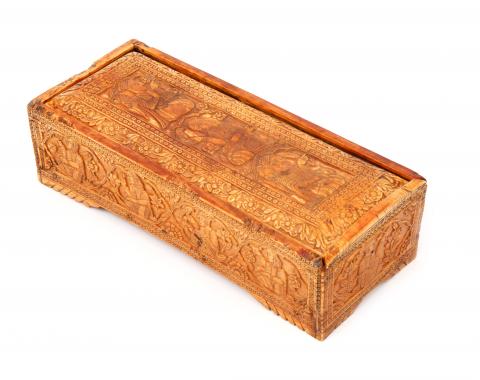Caixa de Escrita
Writing box
Ivory
Deccan Sultanates, Maharashtra, 17th/18th century
Dim.: 5.7 x 24.5 x 11.0 cm
Caixa de Escrita
Marfim
Sultanato do Decão, Maharastra, Séc. XVII /XVIII
Dim.: 5,7 x 24,5 x 11,0 cm
Ivory parallelepiped writing box of sliding cover, raised on four bracket feet, featuring four delicately carved elevations of elegant lobate cartouches interspersed with flowers – chrysanthemums, carnations and lotus. The lid decorative composition is defined by a sequence of Persian style niches.
Within the cartouches female and male cross-legged figures seated on the ground and holding small birds, flowers and wine cup, in a language of courtly erudition that illustrates the palatial pleasures favoured by the Deccan courts in central India.
Identical courtly imagery was also adopted for the sliding cover decoration, the female figures portrayed in saris, in the Hindustani fashion, and the male in turbans. This delicately carved ground is framed by double geometric border, ending in a spiral entwined floral frieze in the Persian taste. On the inner lid, hidden from preying eyes, a curious depiction of Shiva, the “Destroyer” god in the Hindu triad, portrayed as a sculptural idol, or murti, on a stepped stand as is common in related devotional imagery.
Most certainly a courtly object related to the act of writing, this box hides in its interior a religious figure whose devotion would be hampered in an essentially Islamic court, and one that evidences the cultural, religious and aesthetic synthesis between the Islamic Persian and the Southern Indian Hindu traditions. This symbiotic relationship illustrates a characteristic of both the Northern India Moghul culture and the Deccan Islamic courts in present day State of Maharashtra.
Hugo Miguel Crespo
Centro de História – University of Lisbon
Bibliography:
Haidar, Navina Najat; Sardar, Marika (eds.), Sultanates of the South. Arts of India's Deccan Courts, 1323-1687, New York, The Metropolitan Museum of Art, 2011.
Michell, George; Zebrowski, Mark, Architecture and Art of the Deccan Sultanates, Cambridge, Cambridge University Press, 1999.
Rara caixa paralelepipédica em marfim com tampa deslizante, elevada por cantoneiras. Apresenta quatro faces entalhadas e decoradas com reservas polilobadas separadas por flores - crisântemos, cravos, flores-de-lotus - e com edículas de tipo persa na tampa.
As reservas apresentam campo alternando figuras femininas e masculinas, sentadas no chão com as pernas dobradas, segurando ora pequenos pássaros, ora flores ou garrafa de vinho, numa linguagem de fina erudição cortesã, denotando os prazeres áulicos das cortes do Decão, no centro da Índia. O mesmo tipo de figuração surge na face exterior da tampa, com um modelo de figuras palacianas semelhante, elas vestindo sari à moda hindustânica e eles trajando turbante. Estes campos finamente entalhados apresentam cercadura dupla de tipo geométrico com círculos, que termina num de friso de flores enlaçadas em espiral ao gosto persa.
No interior da tampa, cuidadosamente apartado dos olhares mais indiscretos, uma curiosa figuração de Shiva, o deus destruidor da tríade Hindu, representado como ídolo escultórico ou murti, sobre base em socalcos, típica deste género de escultura devocional.
Trata-se claramente de uma peça de corte, destinada provavelmente à escrita - escondendo no seu interior uma figuração religiosa cuja devoção seria dificultada numa corte predominantemente islâmica – e onde se observa a síntese cultural, religiosa e estética entre a tradição islâmica persa e a Hindu do Sul da Índia. Uma simbiose que caracteriza tanto a cultura mogol do Norte da Índia, como a das cortes islâmicas do Decão, no actual estado do Maharashtra.
Hugo Miguel Crespo, Historiador de Arte, C.H. – F.L.U.L.
Bibliografia:
Haidar, Navina Najat; Sardar, Marika (eds.), Sultanates of the South. Arts of India's Deccan Courts, 1323-1687, Nova Iorque, The Metropolitan Museum of Art, 2011.
Michell, George; Zebrowski, Mark, Architecture and Art of the Deccan Sultanates, Cambridge, Cambridge University Press, 1999.
- Arte Colonial e Oriental
- Artes Decorativas
- Marfim, Tartaruga e Madrepérola

